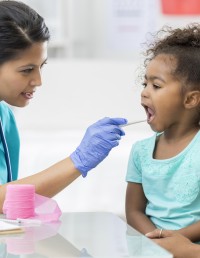Landmark report tracks, highlights key health outcomes for youth in foster care
California report — the first of its kind — reveals areas in need of improvement
Every young person should have the right to healthy sexual development and bodily autonomy as they pursue relationships and build the lives and futures they envision for themselves.
This simple truth is what drives the Reproductive Health Equity Project for Foster Youth (RHEP), a collaborative of public and private agencies led by the National Center for Youth Law. And it's why the National Center for Youth Law and the RHEP team are excited to work with California lawmakers and other stakeholders to improve protections following the release this month of an unprecedented report on sexual and reproductive healthcare services, training and education in the state.
The California Department of Social Services (CDSS) on Sept. 26 released “Performance and Outcome Data on the Implementation of Sexual and Reproductive Health Training and Education: Report to the Legislature” — an extensive report focused on reproductive and maternal health outcomes for young people in California's foster care system. The report, which is the first of its kind among U.S. states, is the result of a collaborative effort between the CDSS and the Department of Health Care Services, as required by the Healthy Futures for Foster Youth Act (Assembly Bill 172) passed in 2021.
The report revealed some promising findings, as well as areas critically in need of improvement. The data suggests youth in foster care are doing well when it comes to annual health visits, and that some key professionals, including judges and group home administrators, are receiving training about youth reproductive rights at high rates. But the report also highlights that the state is failing to meet the maternal health needs of pregnant foster youth and their infants, and is particularly falling short in supporting Black youth in foster care who are expecting or parenting. It also calls out areas in which additional data would be helpful to understand outcomes and where and how to target support, such as data from California’s FamilyPACT program and data on training rates for child welfare social workers. The report disaggregates data by race and ethnicity, which allows for more insightful analysis, and the results suggest that disaggregating by other variables, such as county of placement, would be important in future reports.
“We applaud the efforts of Assemblymember Blanca Rubio, the California Legislature, and Governor Gavin Newsom for continuing to lead the way in ensuring that youth in foster care receive the health care and education they need, want and deserve," said Cindy Cruz, RHEP director. "We also thank the California Department of Social Services, the Department of Health Care Services, and the California Department of Public Health for their work in making this report a reality.”
Members of the RHEP collaborative's youth advisory board also commended the state for implementing this important data collection.
“I absolutely love it," said Cody Van Felden, a youth advisory board member. "Just being able to see and being able to keep track. I mean having these percentages and being able to have them every year, we’ll be able to really help keep track of where things are going.”
Roadmap for policy reform
As it continues to analyze the inaugural report's data, the National Center for Youth Law and its RHEP collaborative partners — a group that includes AB 172 cosponsors the Alliance for Children’s Rights, Black Women for Wellness Action Project, Children’s Law Center of California, and John Burton Advocates for Youth — will engage its youth advisory board and other experts to prepare policy recommendations that it will issue in the coming weeks.
Providing youth in foster care with proper access to reproductive and sexual health education and services, including maternal and infant care, should be a priority. Several previous private studies have revealed that youth in foster care face higher than average rates of sexually transmitted infection and unintended pregnancy. According to one such study, by age 21, about 60% of females in California foster care have been pregnant at least once, the majority of such pregnancies unintended, and about 40% are parents.
"This [annual report] helps us to be able to see where youth need more support," said Elyzabeth Andersen, another member of the youth advisory board. "We're able to take action and make changes and see if that action actually is making a difference or not when we have a report to look back on each year. It’s kind of a way to help hold people accountable, like 'OK, you’re saying you're doing this and you’re saying you’re helping, but do the statistics show that or not?'"
Highlights from the Report
California is the first state in the nation to require its child welfare agency to report comprehensively on the sexual and reproductive health outcomes for youth in foster care and to also commit to issuing such reports annually. This commitment is critical; the collected data will help identify possible disparities between youth in foster care and youth in the general population, as well as possible disparities within subpopulations in foster care, allowing for better targeting of support.
While RHEP will issue a more in-depth analysis and response in the coming weeks, an initial review uncovered several interesting findings and raised several questions. Among them:
The report uplifted some promising findings, including:
Youth in foster care are accessing annual “well-care” visits at a higher rate than others.
- Well-care visits refer to comprehensive visits with a primary care provider or OB/GYN and are specifically designed to be a space to promote healthy behaviors, address risks and refer to specialized care as necessary. The American Academy of Pediatrics recommends annual well-care visits for all adolescents and suggests they provide an ideal opportunity to share anticipatory guidance and address sexual and reproductive health needs.
- The report shows that youth in foster care ages 10 to 20 completed annual well-care visits at a much higher rate than the same-age Medi-Cal population (62.8% vs 46.7%), and this held true across all racial and ethnic groups.
- With so many youth visiting a provider for a well-care visit, it raises the question whether health care providers are leveraging these visits to address sexual and reproductive health. The RHEP Collaborative youth advisory board looks forward to further exploring this question.
A high percentage of juvenile judges received training about youth reproductive rights and how to support the healthy sexual development of youth in foster care.
- In 2017, California passed the Foster Youth Sexual Health Education Act (SB 89), which, among other things, mandates training for juvenile court judges and officers, social workers, and group home administrators on the sexual and reproductive health rights of youth in foster care, the obligations of caregivers and child welfare officials to support access to care, and how to communicate effectively about healthy sexual development and local resources.
- The report shows that approximately 96% (220 out of 229) of juvenile judges appointed in 2021 had received this initial training.
- Members of the RHEP Collaborative youth advisory board applauded this result, but wonder if this has or will translate to changes in practice, as they believe judges can play an important role in ensuring youth receive the services and support to which they are entitled. “Does it change the outcomes for those they are actually servicing, or is it that they did the training and that’s it?" Van Felden, youth advisory board member, asked. "Because 96% is a really good number, but if the outcomes aren’t matching, then there's a disconnect.”
The report also uncovered some areas of deep concern:
Pregnant foster youth are less likely to receive prenatal and postpartum care compared to same age pregnant persons not in foster care.
- Initiation of prenatal care during the first trimester of pregnancy facilitates a comprehensive assessment of a pregnant person’s health history, pregnancy risk, and health knowledge. Early screening and referrals for specialized care can prevent pregnancy complications resulting from pre-existing health conditions or promote access to recommended care.
- The report shows that only about half of pregnant foster youth ages 10 to 20 received prenatal care during the first trimester of their pregnancy (55.2%) in 2020. This is lower than the rate for the same-age Medi-Cal population not in care (64.1%). Notably, 2020 data from the California Department of Public Health suggests that almost 90% of Californians overall received timely prenatal care in the comparable time frame.
- Systemic problems, such as gaps in adequate care, confidentiality concerns, provider bias, and logistical challenges, have been documented in the past and may help explain this disparity, but it is crucial to explore why this may be happening.
- Foster youth were also more likely to give birth to a low-weight infant (child weighing less than 2,500 grams) than the same-age Medi-Cal population (9% vs 7%). Low birth weight infants are more likely to experience severe health and developmental difficulties. This data raises questions about what may be causing this disparity. While better access to prenatal care is certainly important, there also may be other factors at play, such as chronic health conditions or lack of access to healthy food and housing, that are leading to lower birth weights.
- The report shows that foster youth who gave birth received postpartum care at a lower rate than the same-age Medi-Cal population: 52.9% as compared to 67% for the same-age Medi-Cal population. This is a critical gap, as postpartum visits provide an opportunity to assess physical recovery from pregnancy and childbirth, and to address chronic health conditions (such as diabetes and hypertension), mental health status (including postpartum depression), and family planning (including contraception and inter-conception counseling).
- Members of the RHEP Collaborative youth advisory board encourage further exploration of these gaps in postpartum care, suggesting that, again, a range of systemic issues, including transportation problems and fears around family policing, may be contributing factors. Improving access to postpartum care should be a priority, suggested RHEP advisory board member Van Felden, who had her own difficult experience with postpartum depression: “For me, just having the services would have been extremely, like a lot better. Especially once I had my daughter, there was just so much doubt of my ability to even be a parent because I had parents who failed me. So it was just a whirlwind of emotions and my trauma coming up and not really knowing how to handle that — on top of taking care of a newborn. Having those [postpartum] services would have made a difference.”
- Emilio Valladolid, a RHEP youth advisory board member, explained how these issues can have a snowball effect on young parents and why this finding may be an indicator of other problems: "With pregnant and parenting youth, especially young people in foster care, it’s like if you miss one step you kind of have all of these consequences that can affect the rest of the steps you take. So if you don’t get accurate prenatal care, it could have major effects on the fetus and that could have effects on [the pregnant person] and it’s like a tidal wave. So it’s not one of those things where you can say 'OK, we're doing good enough.' No, if there is one issue, there are multiple issues."
Expectant and parenting youth in foster care who identify as Hispanic and Black/African American are faring worse than others in several categories.
- Youth in care who identified as Hispanic had much lower rates of postpartum care (53.3%) than Hispanic youth not in care (69%). Youth in care who identified as Black/African American had lower rates of postpartum care (45.5%) than foster youth overall (52.9%). Notably, Black/African American youth not in care also had lower rates of postpartum care relative to the rate for youth not in care overall (67%). The report flags this discrepancy as a particular concern, recommending that “efforts to increase postpartum care should focus on young Black/African American mothers overall, regardless of foster status.” This is important; however, given the already disproportionately high rate of youth who identify as Black in the foster care system, this should also remain a priority for those focused on youth in care as well.
- Black/African American birthing youth in foster care gave birth to low-birthweight infants at a significantly higher rate (12.4%) than other youth in care and the same-age Medi-Cal population (7%). Notably, Black youth not in care also had much higher rates of low-birthweight infants. The report flags “understanding and addressing the causes of low birth weight deliveries” as a “critical priority.”
Areas for more research and exploration in future reports:
More information on child welfare engagement is necessary to draw conclusions about agency involvement.
- Annual reports are meant to include information about the performance of professionals who have the responsibility to engage with youth in foster care, such as the obligation of social workers to ensure youth receive comprehensive sexual health education. The report notes that “CDSS was unable to obtain data regarding how many foster youth in care have completed [comprehensive sexual health education] due to a lack of reporting and documentation of these practices in the case plan.”
- The report also should include data on the training received by social workers and probation officers. While the report includes some such data, CDSS was limited by what is available to them. For future reports, it may be necessary to build out new sources of information to gain a full understanding of the role of child welfare.
Disaggregated data
- AB 172 requires that annual reports disaggregate data by age, race, ethnicity, sexual orientation, gender identity, county, and county placement type, if possible. The inaugural report disaggregates measures by race and ethnicity, and doing so, uncovered important differences. Expanding this analysis to disaggregate by additional factors no doubt will be very helpful in future reports.
Information on the FamilyPACT program is necessary to draw conclusions about contraception use and services related to sexually transmitted infections.
- It's not clear if the inaugural report includes data from California’s robust FamilyPACT program. The FamilyPACT program offers comprehensive family planning services, including contraception, pregnancy testing, and sexually transmitted infection testing to Californians of reproductive age who qualify, based on income. The FamilyPACT program, which serves hundreds of thousands of Californians each year, is easy to use and confidential and may be an important source for family planning for young people in foster care. In order to be able to draw conclusions about contraceptive access and use and STI testing, it would be important to know whether or not this data includes FamilyPACT information.
Centering youth voices and experiences to understand what's behind the numbers.
- The data included in the report provides a great starting point. "It helps us to be able to see where youth need more support," said Andersen, RHEP youth advisory board member. But members of the RHEP Collaborative youth advisory board also emphasize that the numbers don’t tell us why we may be doing well in some places and not so well in others. They emphasize the need to ask questions of and listen to young people to understand what’s behind the numbers and what supports might be needed.
What’s next?
The RHEP collaborative and its youth advisory board will host a webinar in the coming weeks to delve deeper into the data in the report and present policy and practice recommendations. To be notified of the webinar and recommendations, sign up for RHEP’s listserv here.
For more information about AB 172, about the report, or about the Reproductive Health Equity Project, contact Cindy Cruz, RHEP Director, at [email protected] or Rebecca Gudeman, Senior Director of Health at the National Center for Youth Law, at [email protected].






